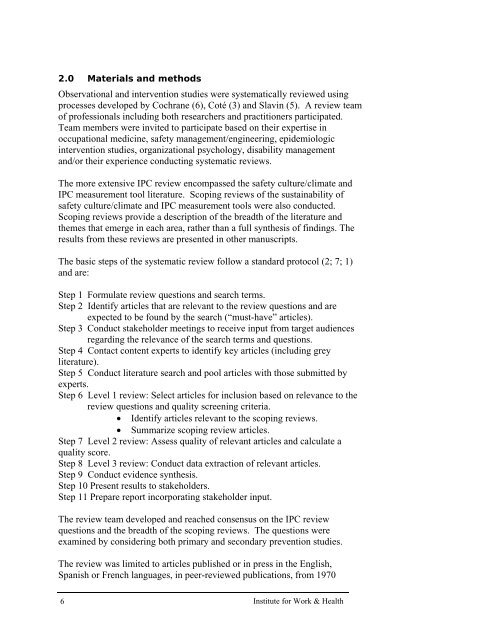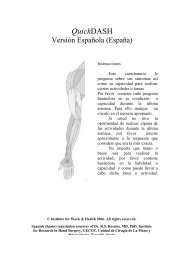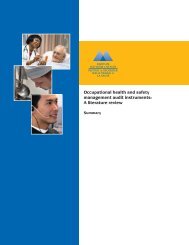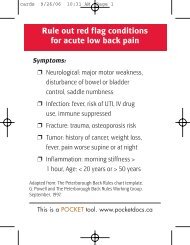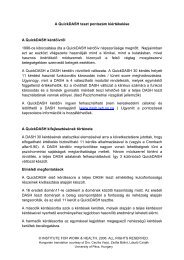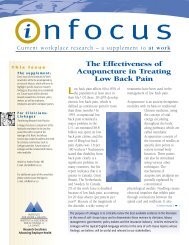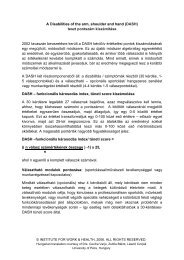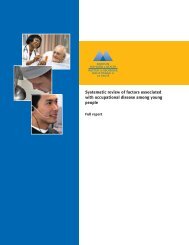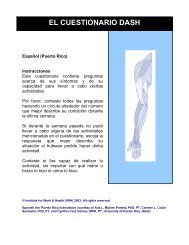A systematic review of injury/illness prevention and loss control ...
A systematic review of injury/illness prevention and loss control ...
A systematic review of injury/illness prevention and loss control ...
- No tags were found...
You also want an ePaper? Increase the reach of your titles
YUMPU automatically turns print PDFs into web optimized ePapers that Google loves.
2.0 Materials <strong>and</strong> methodsObservational <strong>and</strong> intervention studies were <strong>systematic</strong>ally <strong>review</strong>ed usingprocesses developed by Cochrane (6), Coté (3) <strong>and</strong> Slavin (5). A <strong>review</strong> team<strong>of</strong> pr<strong>of</strong>essionals including both researchers <strong>and</strong> practitioners participated.Team members were invited to participate based on their expertise inoccupational medicine, safety management/engineering, epidemiologicintervention studies, organizational psychology, disability management<strong>and</strong>/or their experience conducting <strong>systematic</strong> <strong>review</strong>s.The more extensive IPC <strong>review</strong> encompassed the safety culture/climate <strong>and</strong>IPC measurement tool literature. Scoping <strong>review</strong>s <strong>of</strong> the sustainability <strong>of</strong>safety culture/climate <strong>and</strong> IPC measurement tools were also conducted.Scoping <strong>review</strong>s provide a description <strong>of</strong> the breadth <strong>of</strong> the literature <strong>and</strong>themes that emerge in each area, rather than a full synthesis <strong>of</strong> findings. Theresults from these <strong>review</strong>s are presented in other manuscripts.The basic steps <strong>of</strong> the <strong>systematic</strong> <strong>review</strong> follow a st<strong>and</strong>ard protocol (2; 7; 1)<strong>and</strong> are:Step 1 Formulate <strong>review</strong> questions <strong>and</strong> search terms.Step 2 Identify articles that are relevant to the <strong>review</strong> questions <strong>and</strong> areexpected to be found by the search (“must-have” articles).Step 3 Conduct stakeholder meetings to receive input from target audiencesregarding the relevance <strong>of</strong> the search terms <strong>and</strong> questions.Step 4 Contact content experts to identify key articles (including greyliterature).Step 5 Conduct literature search <strong>and</strong> pool articles with those submitted byexperts.Step 6 Level 1 <strong>review</strong>: Select articles for inclusion based on relevance to the<strong>review</strong> questions <strong>and</strong> quality screening criteria.• Identify articles relevant to the scoping <strong>review</strong>s.• Summarize scoping <strong>review</strong> articles.Step 7 Level 2 <strong>review</strong>: Assess quality <strong>of</strong> relevant articles <strong>and</strong> calculate aquality score.Step 8 Level 3 <strong>review</strong>: Conduct data extraction <strong>of</strong> relevant articles.Step 9 Conduct evidence synthesis.Step 10 Present results to stakeholders.Step 11 Prepare report incorporating stakeholder input.The <strong>review</strong> team developed <strong>and</strong> reached consensus on the IPC <strong>review</strong>questions <strong>and</strong> the breadth <strong>of</strong> the scoping <strong>review</strong>s. The questions wereexamined by considering both primary <strong>and</strong> secondary <strong>prevention</strong> studies.The <strong>review</strong> was limited to articles published or in press in the English,Spanish or French languages, in peer-<strong>review</strong>ed publications, from 19706 Institute for Work & Health


